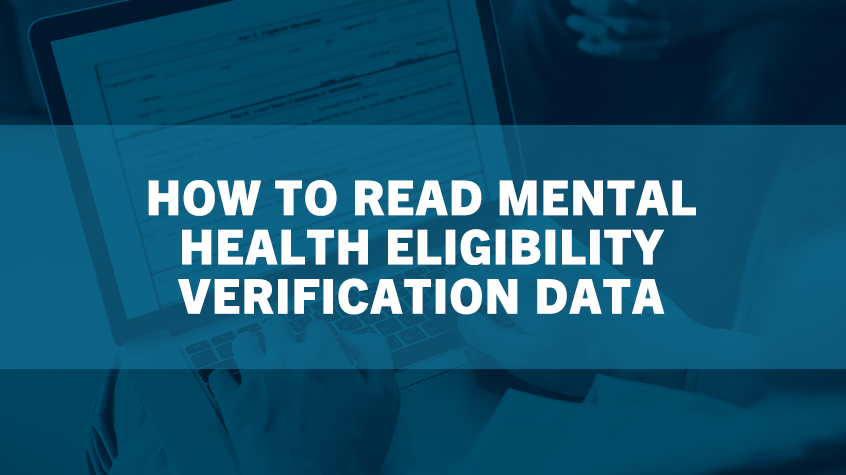Health Information Exchange Integration
Integrated EHR Software
Your patient records are the heart of your practice. From intake to diagnosis and throughout treatment, you rely on having pertinent and accurate information to do your job. But how do you get that information? And how do you transmit it to other behavioral health or medical professionals when necessary?
Too often, the exchange of information between providers is limited and unreliable. Some providers still haven't fully digitized records, and you may have a patient come in clutching a paper copy of some test result you should have received electronically. Electronic health information exchange (HIE) gives both providers and patients a way to securely access and share medical information electronically.
The term refers to two related concepts: the act of exchanging information and the entities facilitating that exchange.
Start Free Trial
*By submitting this form, you consent to receive calls or texts from an automated telephone dialing system. Reply STOP to opt out. No purchase is necessary.
The Importance of Health Information Exchanges
Electronic health records (EHRs) have become the most widely-used form of information storage. As of 2017, 96 percent of non-federal hospitals used an EHR. Even so, the actual transmission of the information contained in EHRs is often inefficient or even incomplete. It's still common for providers to use mail or fax to send information, which is rife with the possibility for miscommunication.
In 2018, nearly a third of people who visited a health care provider experienced a gap in the exchange of their information. These gaps forced patients to do one or more of these things:
- Redo a procedure or test because prior results were unavailable.
- Give medical history again because of a missing chart.
- Wait longer than seemed reasonable for test results.
- Bring test results to an appointment.
Health information exchanges (HIEs) reduce these occurrences by getting patient information into the hands of providers who need it, in a timely manner. Behavioral health professionals can reap significant HIE benefits as well. Receiving up-to-date information about patients enhances collaborative care, leading to better outcomes on both the medical and clinical side of treatment.
Integrated mental health care is excellent for improving prevention and treatment. Being able to access a patient's information gives a behavioral health team a more complete picture of the patient's health. It helps clarify any barriers to adherence in treatment and spot potential issues before prescribing a controlled substance.
Drug-to-drug interactions are one concern that HIEs address very effectively. While most patients are capable of listing medications they take during the intake process, it shouldn't be their responsibility to keep you up to date on changes in dosage or new medications.
For instance, let's say you are seeing a patient you believe would do well on Abilify®. However, your patient has forgotten to update their information to include their new Wellbutrin® prescription. A prompt HIE from their primary care provider would allow you to re-evaluate that prescription decision based on your knowledge of the two drugs' adverse interactions.
In short, HIEs get more critical patient information to the providers who need it to make crucial decisions about treatment.
Types of Health Information Exchanges
Health information exchange is governed by four different types of organizations:
- State-wide HIE: These are operated by the governments of different states, or the state's designated entity (SDE). Some of the state-wide HIEs act as aggregators for different private HIEs.
- Private/Proprietary HIE: These focus on one single community or network. They are usually based within one organization and may include hospital networks, HIEs based on payers and HIEs based on specific diseases.
- Hybrid HIE: These often include collaborations among organizations like an accountable care organization (ACO) and a vendor network operating within a state or a region inside a state.
- Regional or Community HIE: These are inter-organizational and draw funds from a variety of sources. Most of the time, regional and community HIEs are not-for-profit.
Health Information Exchange Architecture
There are three types of health information exchanges used today:
- Directed Exchange: This type of HIE is directed and performed by health care providers. It allows them to send and receive information securely through electronic channels. The information transmitted can include test results, referrals and discharge summaries, for example.
- Query-Based Exchange: In this HIE format, providers can search for or request information pertaining to a patient from other providers. This HIE architecture is especially useful for emergency or unplanned care.
- Consumer-Mediated Exchange: This form of HIE puts the power in patients' hands, allowing them to collect and manage their own health information via the internet. They can transfer information from provider to provider as well as correct certain types of errors when necessary.
In an HIE ecosystem that's working well, providers and patients will use all three types of exchange architecture.
What States Have HIEs?
Every state has an HIE system, though the structure and governance vary widely from state to state. The push toward better interconnectivity began in 2009 with the implementation of the American Reinvestment and Recovery Act (ARRA). One of ARRA's key measures is the Health Information Technology for Economic and Clinical Health (HITECH) act. This act promoted the use of EHRs.
In 2010, The State Health Information Exchange Cooperative Agreement Program awarded funds to 56 states, territories and qualified state-designated entities (SDE) for use in developing HIE programs. The Cooperative Agreement Program was created to assist states in building the capacity for information exchange within and between states.
The recipients of awards were charged with using them to build connectivity and enhance the flow of patient-centric information between appropriate parties to deliver better care. A second round of funds were released to states in 2011. A total of $16 million was allotted so that 10 states could promote development in five key areas, expanding health information exchange goals to include:
- Creating and implementing new requirements for HIE privacy and security.
- Working with Medicaid and state programs to set precedent for a more integrated approach.
- Tracking meaningful use in HIE.
- Developing solutions to close gaps in HIE functionality and capability.
- Meeting national standards.
The success of these grants has not been universal. The most recent available evaluation of the State HIE Cooperative Agreement Program reviewed states on their HIE use score, a measure of how well they used their HIE to improve care. The national HIE use score made a significant jump from 36 percent in 2010 to 79 percent in 2014. However, this impressive increase was driven by just a few states improving their HIE use, not a consistent increase across the board.
What Are the HIE Requirements for EHRs?
There are two acts that govern the requirements for EHRs used to perform HIE. The first and most complex is the Health Insurance Portability and Accountability Act (HIPAA) of 1996. HIPAA was the first stepping stone to health information exchange, regulating how patients' information must be handled with regard to privacy.
The second relevant act is the Medicare Access and CHIP Reauthorization Act (MACRA). MACRA is the current incentive program offered by the Centers for Medicare and Medicaid Services (CMS) to encourage providers to use certified EHR technology.
The Office of the National Coordinator for Health Information Technology (ONC) tests and certifies EHRs based on 60 criteria split into these eight categories:
- Clinical processes
- Care coordination
- Clinical quality measurement
- Privacy and security
- Patient engagement
- Public health
- Health IT design and performance
- Electronic exchange
HIPAA compliance is a major component of an EHR being certified by the ONC. Some states have their own regulations for EHRs, but they are few and vary widely.
Frequently Asked Questions About Health Information Exchanges
The purpose of health information exchanges in enhancing collaborative care is clear, but you may have some further questions about them. These are some of the most frequently asked questions regarding HIEs.
The Future of Health Information Exchanges
Like any form of technology, HIEs must rapidly evolve to meet new challenges and expectations. Professionals in the field often talk about the progress of HIE technology in terms of version number. Today, we're experiencing HIE 2.0. This second generation of health information exchange is concerned with applying modern technology. Cloud services, health apps and connected devices are all becoming integrated into HIE, and patients are coming to expect the ability to access their records electronically.
The next wave of innovation, HIE 3.0, will focus on standardization and interoperability. While the goal of HIEs is to centralize patient information where all relevant providers can access it, the actual logistics of this are difficult. There is no global standard for HIEs, for example, which breaks the continuity of care if someone travels outside the country.
Even within the United States, the connection between HIEs and the EHRs they draw information from is not seamless. The use of Application Programming Interfaces (APIs) could change that. APIs allow databases to interact with each other through the use of third-party scripts, facilitating the transfer of information without permeating the security layer present in both databases. Enhancing interoperability is one of the most important priorities for many health information exchange organizations.
HIEs will also be affected by the emergence and development of artificial intelligence (AI). Once better integration and more seamless transmission are achieved, we will have vast repositories of patient information that can be mined for valuable insights. Machine learning has the potential to revolutionize care by generating predictions based on previous data and the data of other patients. It may one day be able to predict which patients have the highest risk of diabetes or have a higher risk of abusing opioids, allowing for better preventive care and patient outcomes.
ICANotes and Health Information Exchanges
ICANotes is the most feature-rich EHR designed for behavioral health professionals by behavioral health professionals. As such, we partner with health information exchanges like HealthInfoNet, THA, and Health Information Network. We realize that states have changing requirements for EHR connectivity, and we are constantly working to add new HIEs to our list.
If you require an HIE connection ICANotes doesn't currently have, we're happy to accommodate you. Feel free to submit your request via live chat or contact us through one of our other channels. If you're interested in learning more about our clinically robust EHR software, you can schedule a free trial to see how it works for you.
In today's world of increasing technological engagement, you need an EHR you can trust to create quick and accurate notes while remaining HIPAA-compliant. ICANotes provides an impressive suite of features above and beyond creating better notes, including billing and a patient portal. You'll be able to increase your efficiency and start maximizing your reimbursement, all while increasing the quality of your notes and patient care. See it all in action by registering for a live demo.
More Resources on Integrations and Privacy
Why Narrative Behavioral Health Progress Notes Matter
Why Narrative Behavioral Health Progress Notes Matter: How ICANotes Makes Charting Effortless…
Read MoreInformed Consent and AI in Healthcare: Ethical Considerations for Behavioral Health Providers
Informed Consent and AI in Healthcare: Ethical Considerations for Behavioral Health Providers…
Read MoreHow to Decide What Rates to Charge for Your Therapy Services
Deciding how much therapy costs can be challenging for even the most…
Read MoreCPT Code 96127: Guide to Mental Health Screening Reimbursement
What is CPT Code 96127 and How Does it Affect Your Income?…
Read MoreWhat Out-of-Network Clinicians Need to Know About Insurance
What Providers Need to Know About Out of Network Reimbursement An out…
Read MoreRecent DSM-5-TR Updates
Recent DSM-5-TR Updates As a behavioral health professional, it’s essential to stay…
Read More6 Reasons Why You Should Avoid Medical Transcribing Services
6 Reasons Why You Should AvoidMedical Transcribing Services Amidst record rates of…
Read MoreAdding and Updating Digital Contact Information in NPPES
Behavioral health providers are no strangers to collaboration and patient file exchanges.…
Read MoreCMS-1500 Claim Form Guide: Accurate Billing for Behavioral Health Providers
A CMS 1500 form is a claim form you will often use…
Read MorePutting Together a Good Faith Estimate
Healthcare rules and regulations are constantly changing. In late 2021, Congress passed…
Read MoreComplete Guide to Mental Health & Behavioral Health Billing
Complete Guide to Mental Health & Behavioral Health Billing If you’re looking…
Read MoreCreating a Professional Will as a Therapist
Mental health clinicians, psychologists and therapists have a number of patients and…
Read More8 Tips for Improving Your Counseling Schedule
As a mental health professional, you likely have a lot on your…
Read MoreHow to Read Mental Health Eligibility Verification Data
Working with insurance can often be one of the most frustrating aspects…
Read MoreHow to get on an Insurance Panel for Mental Health: Step-by-Step Guide
How to Get on an Insurance Panel for Mental Health Professionals Insurance…
Read MoreMental Health Billing Tips for 2022
When you provide mental health care to your clients, your goal is…
Read MoreHow to Choose a Clearinghouse
As a mental and behavioral healthcare provider, you want to give your…
Read MoreWhy You Should Share Behavioral Health Notes With Patients
Sharing Behavioral Health Notes with Patients You might feel a little nervous…
Read MoreWhat to Know About the New E/M Coding Changes for 2022
The Centers for Medicare and Medicaid Services (CMS) and the American Medical…
Read MoreClient Confidentiality in Behavioral Therapy: Best Practices for Therapists
Client Confidentiality: Best Practices for Mental Health Therapists Client confidentiality is a…
Read MoreIntuitive, Accessible, Time-Saving
ICANotes - the only EHR software that actually thinks like a clinician.




















